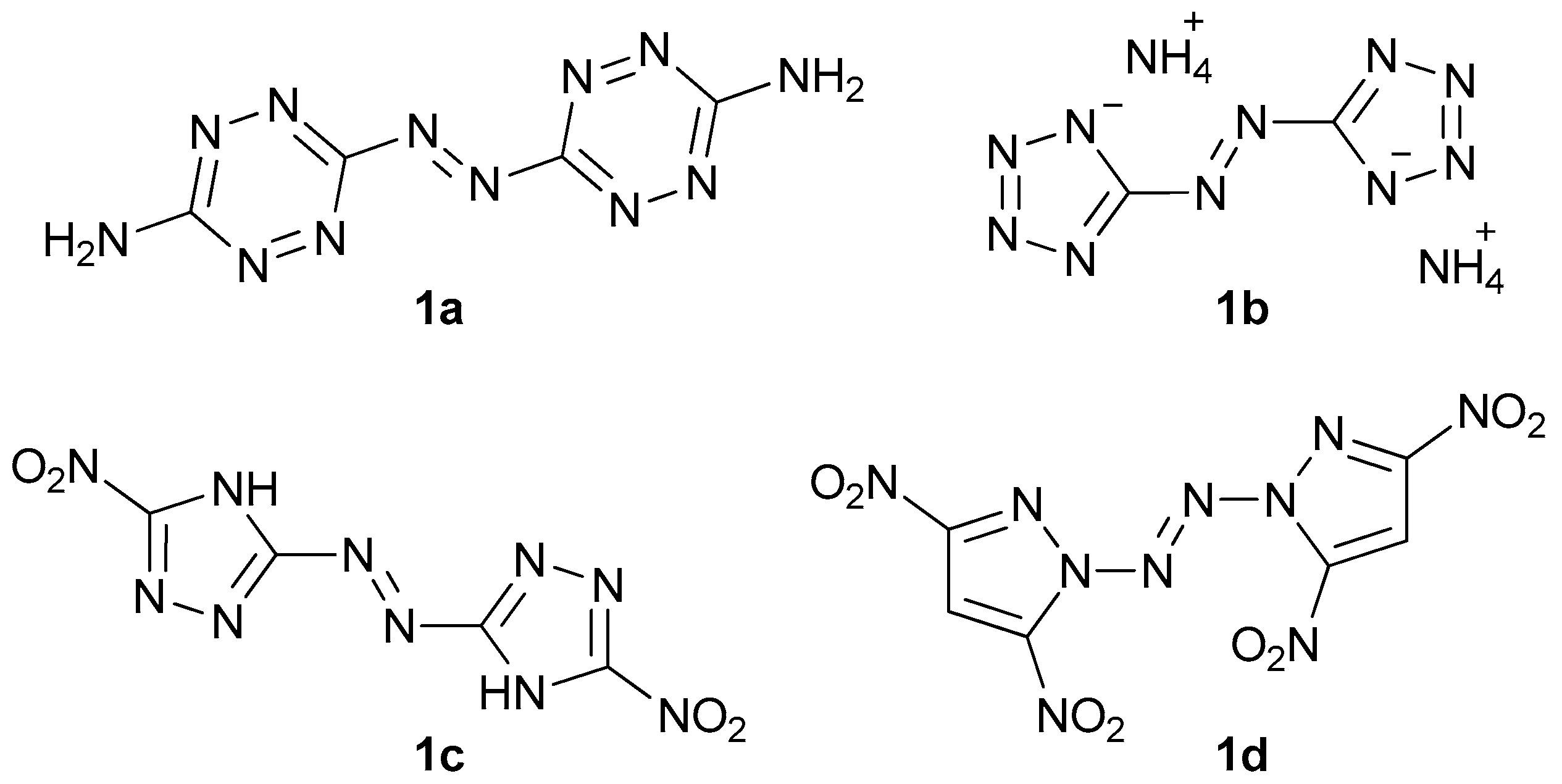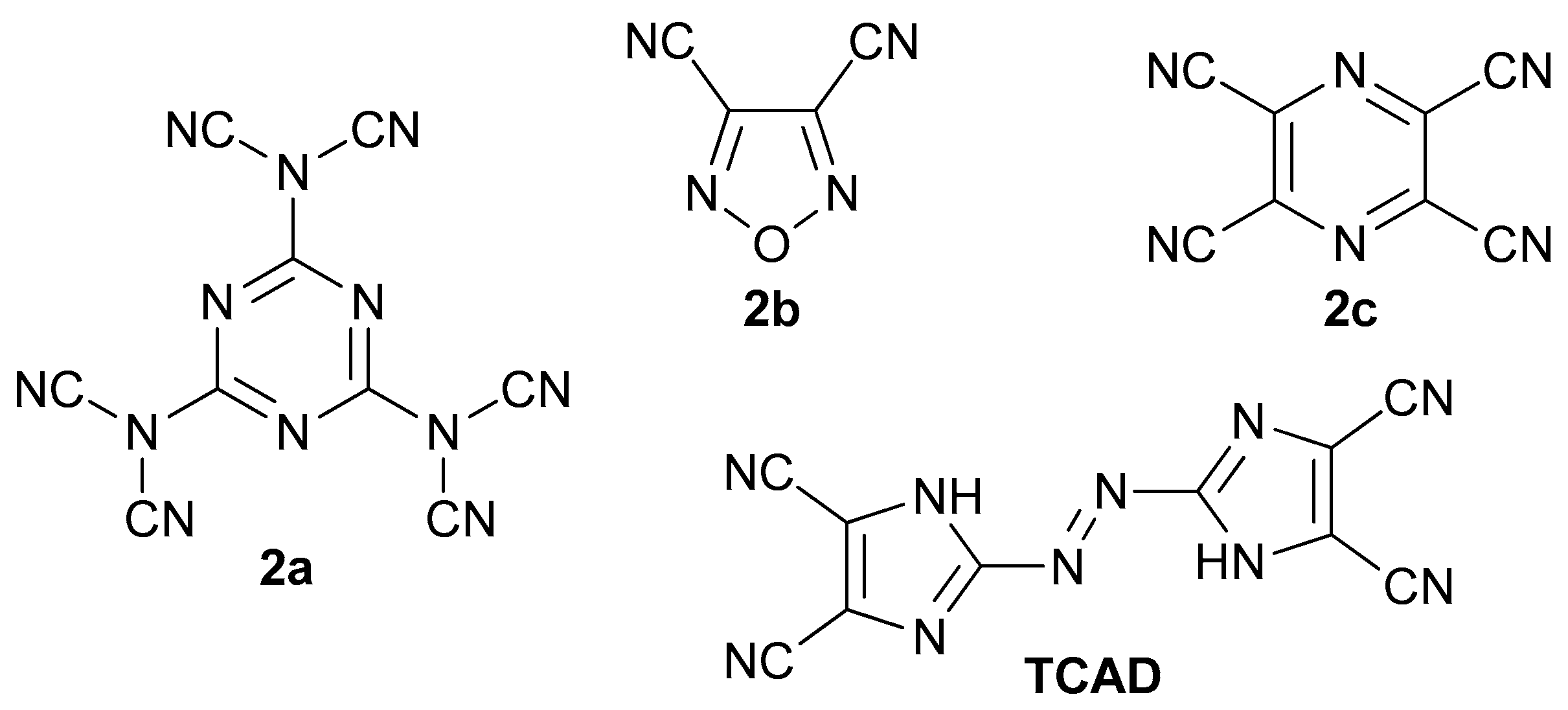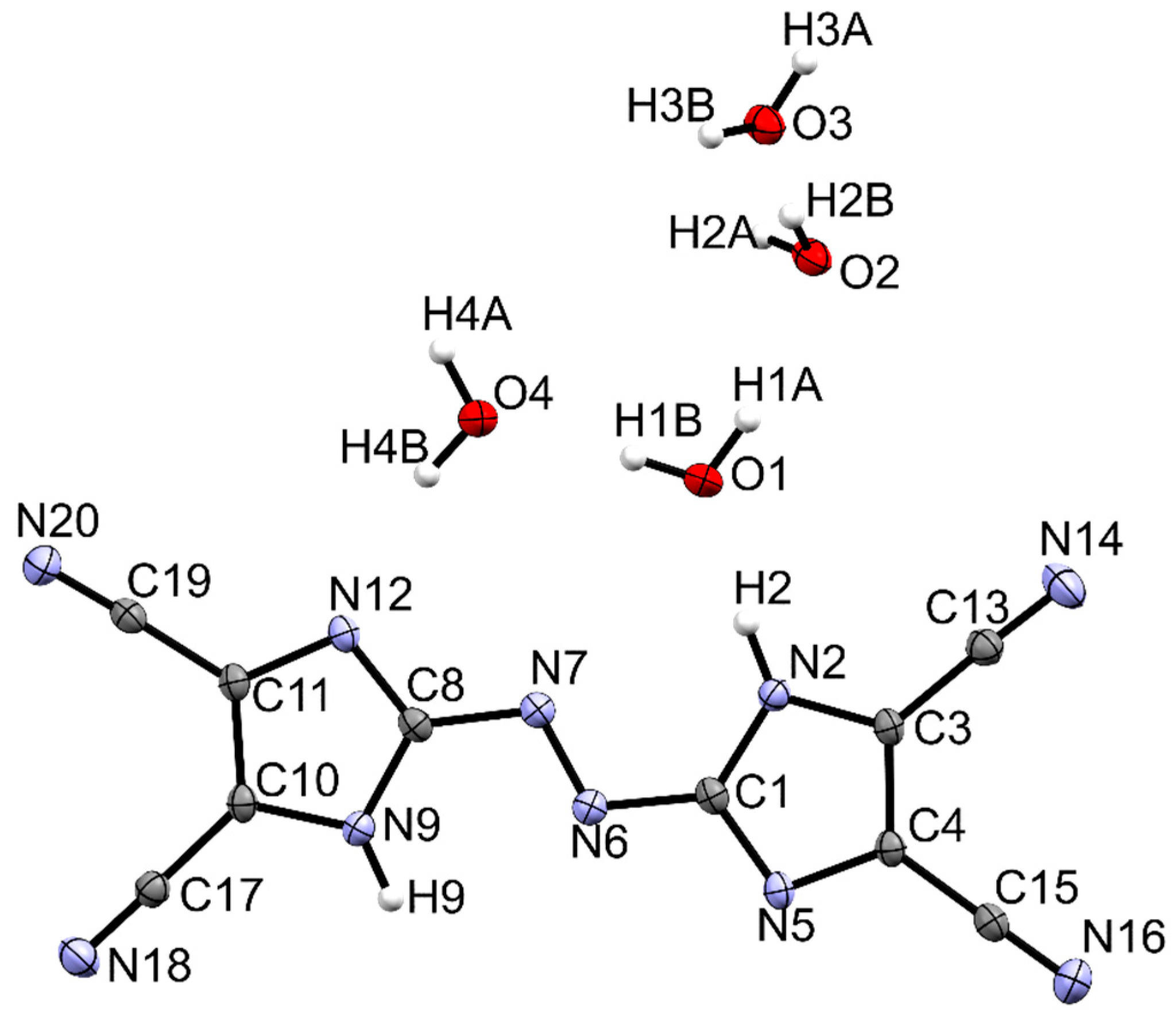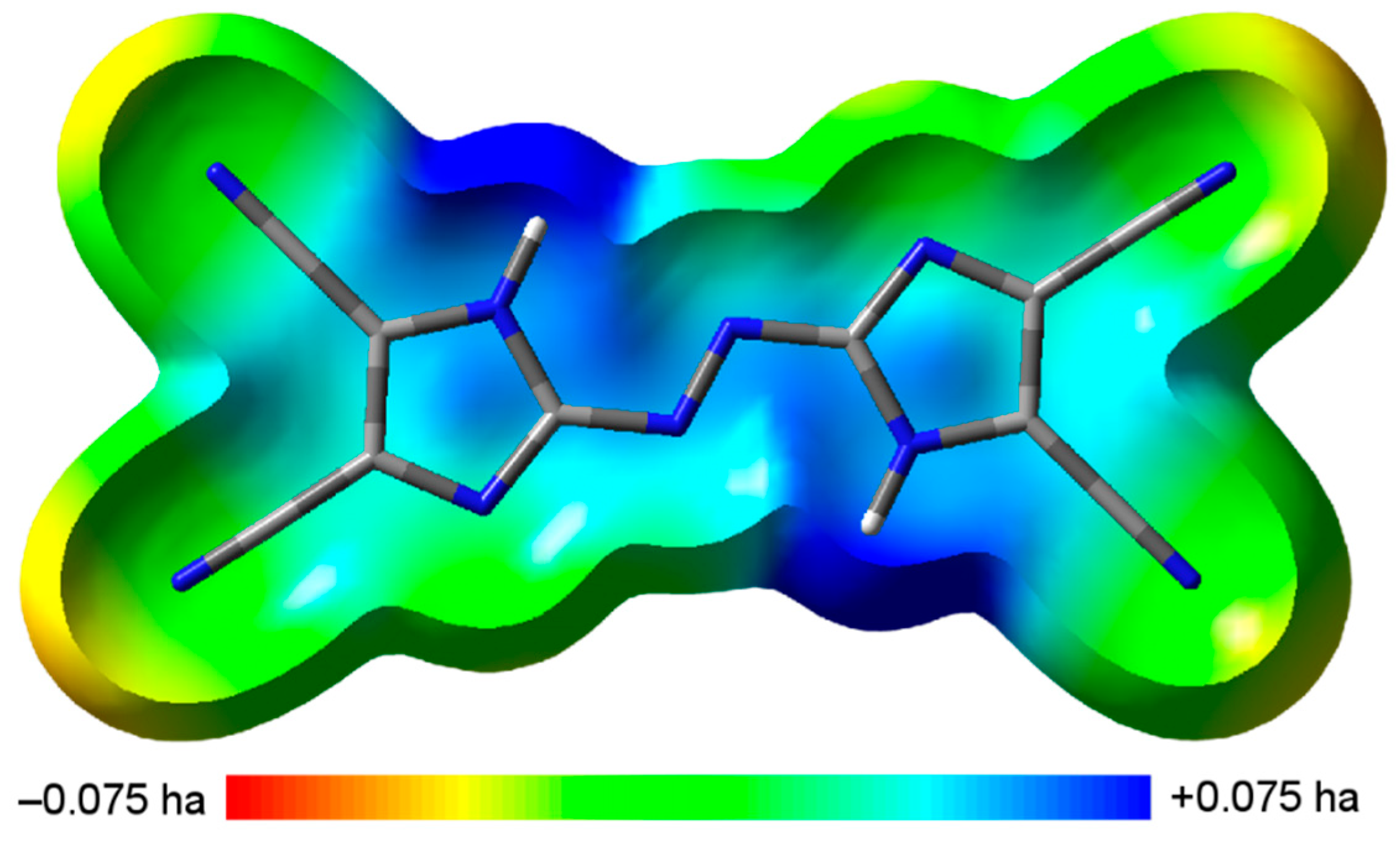Structure and Thermal Properties of 2,2′-Azobis(1H-Imidazole-4,5-Dicarbonitrile)—A Promising Starting Material for a Novel Group of Energetic Compounds
Abstract
:1. Introduction
2. Results and Discussion
2.1. Crystal Structure
2.2. Physiochemical Properties
3. Materials and Methods
3.1. General Information
3.2. Synthesis
3.3. X-Ray Crystallography
3.4. Computations
3.5. Thermal Analysis
4. Conclusions
Supplementary Materials
Author Contributions
Funding
Acknowledgments
Conflicts of Interest
References
- Gao, H.; Shreeve, J.N.M. Azole-based energetic salts. Chem. Rev. 2011, 111, 7377–7436. [Google Scholar] [CrossRef] [PubMed]
- Pagoria, P.F.; Lee, G.S.; Mitchell, A.R.; Schmidt, R.D. A review of energetic materials synthesis. Thermochim. Acta 2002, 384, 187–204. [Google Scholar] [CrossRef]
- Duan, B.; Liu, N.; Wang, B.; Lu, X.; Mo, H. Comparative theoretical studies on a series of nonvel energetic salts composed of 4,8-dihydrodifurazano[3,4-b,e]pyrazine-based anions and ammonium-based cations. Molecules 2019, 24, 3213. [Google Scholar] [CrossRef] [Green Version]
- Zhang, P.; Kumar, D.; Zhang, L.; Shem-Tov, D.; Petrutik, N.; Chinnam, K.A.; Yao, C.; Pang, S.; Gozin, M. Energetic Butterfly: Heat-Resistant diaminodinitro trans-Bimane. Molecules 2019, 24, 4324. [Google Scholar] [CrossRef] [PubMed] [Green Version]
- Wang, G.; Fu, Z.; Yin, H.; Chen, F.-X. Synthesis and properties [1,2,4]triazolo[4,3-b][1,2,4,5]tetrazine N-oxide explosives. Propellants Explos. Pyrotech. 2019, 44, 1010–1014. [Google Scholar] [CrossRef]
- Wingard, L.A.; Sausa, R.C.; Guzmán, P.E.; Pesce-Rodriguez, R.; Sabatini, J.; Drake, G.W. Synthesis of bis-isoxazole-bis-ethylene dinitrate and bis-isoxazole-tetra-ethylene tetranitrate: Potential energetic plasticizers. Propellants Explos. Pyrotech. 2019, 44, 617–622. [Google Scholar] [CrossRef]
- Qu, Y.; Babailov, S.P. Azo-linked high-nitrogen energetic materials. J. Mater. Chem. A 2018, 6, 1915–1940. [Google Scholar] [CrossRef]
- Chavez, D.E.; Hiskey, M.A.; Gilardi, R.D. 3,3′-Azobis(6-amino-1,2,4,5-tetrazine): A novel high-nitrogen energetic material. Angew. Chem. Int. Ed. 2000, 39, 1791–1793. [Google Scholar] [CrossRef]
- Hiskey, M.A.; Goldman, N.; Stine, J.R. High-nitrogen energetic materials derived from azotetrazolate. J. Energy Mater. 1998, 16, 119–127. [Google Scholar] [CrossRef]
- Naud, D.L.; Hiskey, M.A.; Harry, H.H. Synthesis and explosive properties of 5,5′-dinitro-3,3′-azo-1H-1,2,4-triazole (DNAT). J. Energy Mater. 2003, 21, 57–62. [Google Scholar] [CrossRef]
- Li, Y.-N.; Shu, Y.-J.; Wang, Y.-L.; Wang, B.-Z.; Zhang, S.-Y.; Bi, F.-Q. Synthesis, structure and energetic properties of a catenated N6, polynitro compound: 1,1’-azobis(3,5-dinitropyrazole). Cent. Eur. J. Energy Mater. 2017, 14, 321–335. [Google Scholar] [CrossRef]
- Song, J.; Wang, K.; Liang, L.; Bian, C.; Zhou, Z. High-energy-density materials based on 1-nitramino-2,4-dinitroimidazole. RSC Adv. 2013, 3, 10859–10866. [Google Scholar] [CrossRef]
- Yin, P.; He, C.; Shreeve, J.M. Fully C/N-polynitro-functionalized 2,2′-biimidazole derivatives as nitrogen- and oxygen-rich energetic salts. Chem. Eur. J. 2016, 22, 2108–2113. [Google Scholar] [CrossRef] [PubMed]
- Breiner, M.M.; Chavez, D.E.; Parrish, D.A. Nucleophilic reactions of the bis ammonium salt of 4,4′,5,5′-tetranitro-2,2′-biimidazole. Synlett 2013, 24, 519–521. [Google Scholar] [CrossRef]
- Xu, Y.; Shen, C.; Lin, Q.; Wang, P.; Jiang, C.; Lu, M. 1-Nitro-2-trinitromethyl substituted imidazoles: A new family of high performance energetic materials. J. Mater. Chem. A 2016, 4, 17791–17800. [Google Scholar] [CrossRef]
- Kreutzberger, A.; Schücker, R. Aliphatische Substitution in der Reihe der 2,2′-Azoimidazole. 10. Mitt. Kondensationen mit Hydrazin-N,N′-dicarbonsäure-diamidin. Arch. Pharm. 1972, 305, 935–940. [Google Scholar] [CrossRef]
- Kreutzberger, A. Condensations with 1,2-hydrazinedicarboxamidine. II. 2,2’-Azoimidazoles. J. Org. Chem. 1962, 27, 886–891. [Google Scholar] [CrossRef]
- Kreutzberger, A.; Schücker, R. 2,2’-Azoimidazolbildung durch cyclische Acyloine. 8. Mitt.: Kondensationen mit Hydrazin-N,N′-dicarbonsäure-diamidin. Arch. Pharm. 1972, 305, 400–405. [Google Scholar] [CrossRef]
- Bull, J.N.; Scholz, M.S.; Coughlan, N.J.A.; Bieske, E.J. Isomerisation of an intramolecular hydrogen-bonded photoswitch: Protonated azobis(2-imidazole). Phys. Chem. Chem. Phys. 2017, 19, 12776–12783. [Google Scholar] [CrossRef] [Green Version]
- Weston, C.E.; Richardson, R.D.; Fuchter, M.J. Photoswitchable basicity through the use of azoheteroarenes. Chem. Commun. 2016, 52, 4521–4524. [Google Scholar] [CrossRef] [Green Version]
- Rumyantsev, V.G.; Ivashchenko, A.V.; Muratov, V.M.; Lazareva, V.T.; Prudnikova, E.K.; Blinov, L.M. Dyes witth negative dichorism for liquid crystal displays based on the guest-host effect. Mol. Cryst. Liq. Cryst. 1983, 94, 205–212. [Google Scholar] [CrossRef]
- Carlson, B.A. 2,2’-Azobis(4,5-imidazoledicarbonitrile) and derivatives. US4083843A, 11 April 1978. [Google Scholar]
- Godovikova, T.I.; Vorontsova, S.K.; Konyushkin, L.D.; Firgang, S.I.; Rakitin, O.A. Synthesis of 5-(1,2,5-oxadiazol-3-yl)-1H-tetrazoles from 3-cyano-1,2,5-oxadiazoles. Russ. Chem. Bull. 2009, 58, 406–409. [Google Scholar] [CrossRef]
- Rao, M.H.; Ghule, V.D.; Muralidharan, K. 2,4,6-Tris[bis(1H-tetrazol-5-yl)amino]-1,3,5-triazine as a nitrogen-rich material. J. Chem. Sci. 2017, 129, 657–661. [Google Scholar] [CrossRef]
- Witkowski, T.G.; Sebastiao, E.; Gabidullin, B.; Hu, A.; Zhang, F.; Murugesu, M. 2,3,5,6-Tetra(1H-tetrazol-5-yl)pyrazine: A thermally stable nitrogen-rich energetic material. ACS Appl. Energy Mater. 2018, 1, 589–593. [Google Scholar] [CrossRef]
- Frisch, M.J.; Trucks, G.W.; Schlegel, H.B.; Scuseria, G.E.; Robb, M.A.; Cheeseman, J.R.; Scalmani, G.; Barone, V.; Mennucci, B.; Petersson, G.A.; et al. Gaussian 09, Revision E.01; Gaussian, Inc.: Wallingford, CT, USA, 2009. [Google Scholar]
- Qi, C.; Li, S.-H.; Li, Y.-C.; Wang, Y.; Zhao, X.-X.; Pang, S.-P. Synthesis and Promising Properties of a New Family of High-Nitrogen Compounds: Polyazido- and Polyamino-Substituted N,N′-Azo-1,2,4-triazoles. Chem. Eur. J. 2012, 18, 16562–16570. [Google Scholar] [CrossRef] [PubMed]
- Thottempudi, V.; Shreeve, J.n.M. Synthesis and Promising Properties of a New Family of High-Density Energetic Salts of 5-Nitro-3-trinitromethyl-1H-1,2,4-triazole and 5,5′-Bis(trinitromethyl)-3,3′-azo-1H-1,2,4-triazole. J. Am. Chem. Soc. 2011, 133, 19982–19992. [Google Scholar] [CrossRef] [PubMed]
- Hammerl, A.; Holl, G.; Kaiser, M.; Klapötke Thomas, M.; Mayer, P.; Piotrowski, H.; Vogt, M. Methylated Ammonium and Hydrazinium Salts of 5,5′-Azotetrazolate. Z. Naturforsch. 2001, 56, 847. [Google Scholar] [CrossRef]
- Desiraju, G.R.; Steiner, T. The weak Hydrogen Bond in Structural Chemistry and Biology; Oxford University Press: New York, NY, USA, 1999. [Google Scholar]
- Matus, M.H.; Arduengo, A.J.; Dixon, D.A. The Heats of Formation of Diazene, Hydrazine, N2H3+, N2H5+, N2H, and N2H3 and the Methyl Derivatives CH3NNH, CH3NNCH3, and CH3HNNHCH3. J. Phys. Chem. A 2006, 110, 10116–10121. [Google Scholar] [CrossRef]
- Pittam, D.A.; Pilcher, G. Measurements of heats of combustion by flame calorimetry. Part 8.—Methane, ethane, propane, n-butane and 2-methylpropane. J. Chem. Soc. Faraday Trans. 1972, 68, 2224–2229. [Google Scholar] [CrossRef]
- Jiménez, P.; Roux, M.V.; Turrión, C.; Gomis, F. Thermochemical properties of N-heterocyclic compounds I. Enthalpies of combustion, vapour pressures and enthalpies of sublimation, and enthalpies of formation of pyrazole, imidazole, indazole, and benzimidazole. J. Chem. Thermodyn. 1987, 19, 985–992. [Google Scholar] [CrossRef]
- Murray, J.S.; Lane, P.; Politzer, P. Relationships between impact sensitivities and molecular surface electrostatic potentials of nitroaromatic and nitroheterocyclic molecules. Mol. Phy. 1995, 85, 1–8. [Google Scholar] [CrossRef]
- Murray, J.S.; Lane, P.; Politzer, P. Effects of strongly electron-attracting components on molecular surface electrostatic potentials: Application to predicting impact sensitivities of energetic molecules. Mol. Phys. 1998, 93, 187–194. [Google Scholar] [CrossRef]
- Rice, B.M.; Hare, J.J. A quantum mechanical investigation of the relation between impact sensitivity and the charge distribution in energetic molecules. J. Phys. Chem. A 2002, 106, 1770–1783. [Google Scholar] [CrossRef]
- Klapötke, T.M. Chemistry of High-Energy Materials, 4th ed.; De Gruyter: Leck, Germany, 2017. [Google Scholar]
- Dennington, R.; Keith, T.; Millam, J. GaussView, Version 5; Semichem: Shawnee Mission, KS, USA, 2009. [Google Scholar]
- Semenov, N.N. Chemical Kinetics and Chain Reactions; Oxford University Press: New York, NY, USA, 1935. [Google Scholar]
- Abramov, V.G.; Vaganova, N.I. Effect of a side reaction with small heat liberation on the critical thermal-explosion condition of the main self-catalyzed reaction. Combust. Explos. Shock Waves 1978, 14, 660–665. [Google Scholar] [CrossRef]
- Gołofit, T. Thermal behaviour and safety of 1,3,7,9-tetranitrodibenzo-1,3a,4,6a-tetraazapentalen (z-TACOT). Thermochim. Acta 2018, 667, 59–64. [Google Scholar] [CrossRef]
- Hofelich, T.; Thomas, R.C. The use/misuse of the 100 degree rule in the interpretation of thermal hazard tests. In Proceedings of International Symposium on Runaway Reactions; American Institute of Chemical Engineers: Boston, UK; pp. 74–85.
- United Nations. Recommendations on the Transport of Dangerous Goods: Manual of Tests and Criteria, 6th ed.; United Nations Publication: New York, NY, USA; Geneva, Switzerland, 2015. [Google Scholar]
- Sadchikova, E.V.; Mokrushin, V.S. Synthesis and properties of 5-diazoimidazoles and imidazolyl-5-diazonium salts. Russ. Chem. Bull. 2003, 52, 1600–1605. [Google Scholar] [CrossRef]
- Sheldrick, G.M. Crystal structure refinement with SHELXL. Acta Crystallogr. Sect. C 2015, 71, 3–8. [Google Scholar] [CrossRef] [PubMed]
- Curtiss, L.A. Assessment of Gaussian-2 and density functional theories for the computation of enthalpies of formation. J. Chem. Phys. 1997, 106, 1063–1079. [Google Scholar] [CrossRef] [Green Version]
- Rice, B.M.; Pai, S.V.; Hare, J. Predicting heats of formation of energetic materials using quantum mechanical calculations. Combust. Flame 1999, 118, 445–458. [Google Scholar] [CrossRef]
- Byrd, E.F.C.; Rice, B.M. Improved prediction of heats of formation of energetic materials using quantum mechanical calculations. J. Phys. Chem. A 2006, 110, 1005–1013. [Google Scholar] [CrossRef]
- Trouton, F. On molecular latent heat. Philos. Mag. 1884, 18, 54–57. [Google Scholar] [CrossRef]
- Vyazovkin, S.; Burnham, A.K.; Criado, J.M.; Pérez-Maqueda, L.A.; Popescu, C.; Sbirrazzuoli, N. ICTAC Kinetics Committee recommendations for performing kinetic computations on thermal analysis data. Thermochim. Acta 2011, 520, 1–19. [Google Scholar] [CrossRef]
- Srinivas, D.; Ghule, V.D.; Muralidharan, K. Synthesis of nitrogen-rich imidazole, 1,2,4-triazole and tetrazole-based compounds. RSC Adv. 2014, 4, 7041–7051. [Google Scholar] [CrossRef]
Sample Availability: Samples of the compounds are not available from the authors. |






| Parameter | Value |
|---|---|
| Empirical formula | C10H10N10O4 |
| Formula weight [g/mol] | 334.28 |
| Temperature [K] | 100(1) |
| Wavelength [Å] | 0.71073 |
| Crystal system | monoclinic |
| Space group | P21/c |
| Unit cell dimensions: | |
| a [Å] | 10.2935(2) |
| b [Å] | 7.36760(10) |
| c [Å] | 20.1447(4) |
| β [°] | 100.882(2) |
| Volume [Å3] | 1500.27(5) |
| Z | 4 |
| Density [g/cm3] | 1.480 |
| Absorption coefficient [mm−1] | 0.119 |
| F(000) | 688 |
| Crystal size [mm] | 0.07 × 0.13 × 0.27 |
| Theta range for data collection [°] | 2.950 to 26.370 |
| Index ranges | −12 ≤ h ≤ 12, −9 ≤ k ≤ 7, −25 ≤ l ≤ 25 |
| Reflections collected | 12183 |
| Independent reflections | 3067 [R(int) = 0.0159] |
| Completeness to theta=25.242° [%] | 99.9 |
| Refinement method | Full-matr–ix least-squares on F2 |
| Data/restraints/parameters | 3067/0/229 |
| Goodness-of-fit on F2 | 1.035 |
| Final R indices [I > 2sigma(I)] | R1 = 0.0341, wR2 = 0.0921 |
| R indices (all data) | R1 = 0.0364, wR2 = 0.0947 |
| Largest diff. peak and hole | 0.396 and –0.224 |
© 2020 by the authors. Licensee MDPI, Basel, Switzerland. This article is an open access article distributed under the terms and conditions of the Creative Commons Attribution (CC BY) license (http://creativecommons.org/licenses/by/4.0/).
Share and Cite
Lewczuk, R.; Książek, M.; Gańczyk-Specjalska, K.; Cieślak, K. Structure and Thermal Properties of 2,2′-Azobis(1H-Imidazole-4,5-Dicarbonitrile)—A Promising Starting Material for a Novel Group of Energetic Compounds. Molecules 2020, 25, 314. https://doi.org/10.3390/molecules25020314
Lewczuk R, Książek M, Gańczyk-Specjalska K, Cieślak K. Structure and Thermal Properties of 2,2′-Azobis(1H-Imidazole-4,5-Dicarbonitrile)—A Promising Starting Material for a Novel Group of Energetic Compounds. Molecules. 2020; 25(2):314. https://doi.org/10.3390/molecules25020314
Chicago/Turabian StyleLewczuk, Rafał, Maria Książek, Katarzyna Gańczyk-Specjalska, and Katarzyna Cieślak. 2020. "Structure and Thermal Properties of 2,2′-Azobis(1H-Imidazole-4,5-Dicarbonitrile)—A Promising Starting Material for a Novel Group of Energetic Compounds" Molecules 25, no. 2: 314. https://doi.org/10.3390/molecules25020314
APA StyleLewczuk, R., Książek, M., Gańczyk-Specjalska, K., & Cieślak, K. (2020). Structure and Thermal Properties of 2,2′-Azobis(1H-Imidazole-4,5-Dicarbonitrile)—A Promising Starting Material for a Novel Group of Energetic Compounds. Molecules, 25(2), 314. https://doi.org/10.3390/molecules25020314






